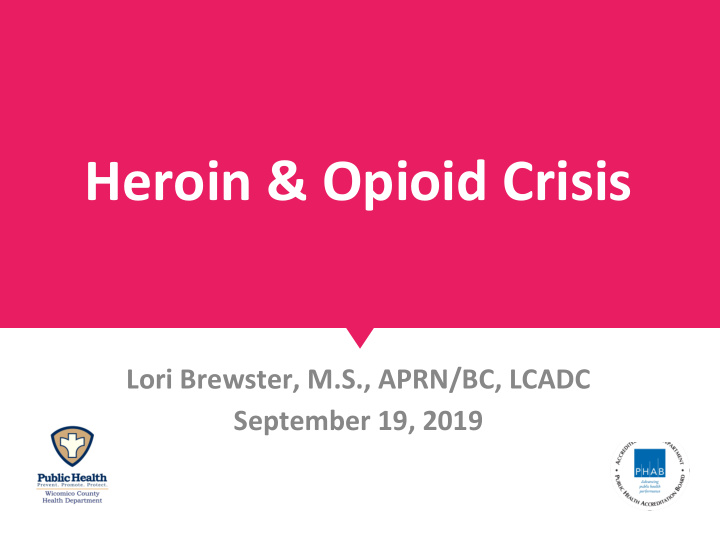



Heroin & Opioid Crisis Lori Brewster, M.S., APRN/BC, LCADC September 19, 2019
○ Unintentional intoxication deaths Heroin in 2018 increased by 4.5 percent to a and total of 2,385 Opioid ○ Opioids accounted for 88.6% of all Overdose unintentional Summary intoxication deaths in Maryland in 2018.
Summary, continued • Opioid-related deaths in 2018 increased by 5.2% as compared to 2017. • This rate of increase is significantly lower than the 8.2% rate of increase in 2017 and dramatically lower than the 70.4% rate increase in 2016. • Fentanyl accounted for 88.3% of all opioid related fatalities in 2018 versus only 8% in 2013 Maryland Department of Health
What Does the Data Show?
So What is the Issue? ● Opiates are having a significant impact on our community: ○ Criminal Activity is on the increase ○ Deaths are on the Increase ○ Health care costs on the increase ● This is a “community” issue – impacts every facet of the community. ● The “Face of Opiate Use” is not what many people think.
How Does Overdose Occur? • Deliberate misuse of a prescription opioid or illicit drug such as heroin; • Prescriber miscalculation of dose; • Error by dispensing pharmacist; • Misunderstanding of directions for use; • Taking a prescription issued for someone else; • Combination of prescribed or illicit opioid with alcohol or other medication.
Who is At Risk? • Anyone using opioids for long-term management of chronic pain; • Individuals discharged from emergency medical care following opioid intoxication; • Detoxification or abstinent for a period of time; • Combining other medications; • Recently released from incarceration.
Why the Increase in OD Deaths? • Crack down on Prescription Drug Use; • More Pure Heroin; • When changing from Prescription Drug to Heroin no conversion; • Inclusion of fentanyl with the heroin; • After periods of abstinence, going back to using the same amount of heroin • After periods of treatment • After periods of incarceration
What is the Impact to the Community? • Decrease in the tax base: • Loss of family support – Fewer people with desire to for the individual; reside in the community • Increase in treatment • Decrease in the employment need/costs; base: • Increase in Crime; – Employers having difficulty • Increase cost to the hiring individuals that can pass criminal justice system: a drug test – Law enforcement • Increase in health care costs: – Corrections – $700 billion a year in increased – Judiciary healthcare costs, crime and lost productivity
• Prescription Drug Monitoring Program • Medication Assisted Treatment • Prescription Drop Off Sites So What • Naloxone So What Can Be • Treatment Expansion Is Being • Prevention and Outreach Done? Done to • Peer Support • Prescription Drug Education Address Program for Prescribers • Overdose Fatality Review Teams the Issues? • Case management for Addicted individual • Encourage public to call 911- Good Samaritan Law • COAT Project • Safe Station •
Lori Brewster, MS, APRN/BC, LCADC Wicomico and Somerset County Health Officer 108 East Main Street, Salisbury MD 21801 Phone: (410) 543-6930 Fax: (410) 543-6975 COAT: (443) 783-6875 Email: lori.brewster@maryland.gov Web: www.wicomicohealth.org
Recommend
More recommend